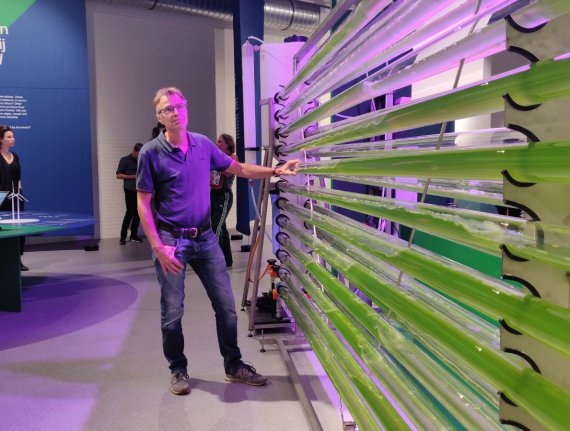Various food ingredients can be obtained from the algae bioreactor filled with green algae biomass, including proteins and unsaturated fats. © Anja Janssen
The fact we must adapt our food pattern to feed the rapidly growing world population and to keep the earth liveable is obvious. But how will we achieve that? Will it be through canned worms, grown sausages, algae pasta, soy burgers or pills based on our individual DNA profiles? While your children are enjoying at Science Museum Nemo, you can step on the ferry to the Marineterrein across the water to find answers to those questions.
For adults
The Future Food exhibition of the new Nemo Science Museum De Studio opened its doors on 10 July. The museum is for adults and is meant to offer more in-depth knowledge than the main Nemo building. You are not allowed to touch each and every part of the exposition, but the colourful space offers quite a lot to experience, nevertheless. You embark on a journey through various alternatives to our current food patterns. You can see how meat is grown, which products may contain black fungus worms and grasshoppers, how vegetable meat substitutes are produced, what functional food from the lab can look like and what kind of ingenious cutlery can stimulate your senses. It is also possible to hear and feel flavours and to pull “functional” food from a snack wall.
Algae bioreactor
The installations and panels were achieved through a collaboration between companies, designers and scientists, including a number of WUR researchers. One such example is the lab version of the shear cell machine by Atze Jan van der Goot, professor of Protein Structure and Sustainability. It enables the conversion of vegetable proteins into meat-like structures. And the tubes of the large algae bioreactor of the LGem company were filled with green algae biomass with the help of Maria Barbosa, professor of Microalgal Biotechnology. Various ingredients can be obtained from algae, such as proteins and unsaturated fats. Professor of Entomology Marcel Dicke collaborated on the table about insects. This table shows which insects are suitable food sources and which snacks can be produced from them. You can also find Wageningen input at the breeding and CRISPR-Cas table.
9 billion stomachs
The Future Food exhibition makes the food of the future tangible and gets you thinking about possible solutions to the global food issue. At the beginning and end of the food journey, visitors are therefore asked how they think we will be able to fill 9 billion stomachs by 2050: with lab food, vegan food, insects, by eating less and locally grown, or simply by not changing anything.
Visit
The exhibition will run until Sunday 6 October and is open from 10:00 to 17:30 at Nemo Science Museum De Studio, Kattenburgerstraat 5, building 027, Amsterdam. The annex is closed on Mondays and Tuesdays. On Wednesday evening, there are workshops, lectures and other events to attend. Further information is available at https://www.nemosciencemuseum.nl/en/activities-at-nemo/exhibitions/future-food/

